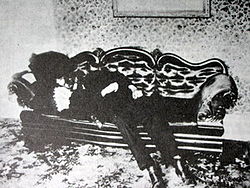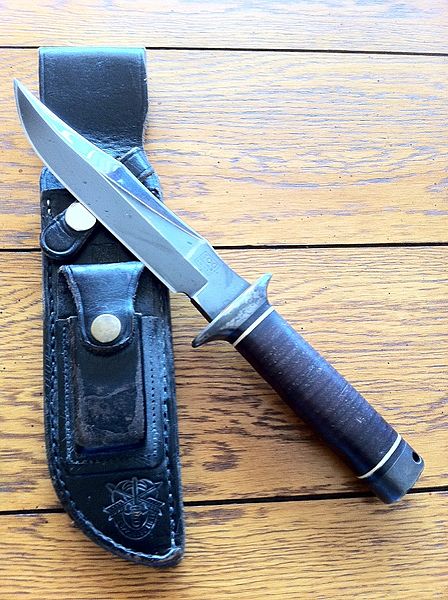Lizzie Borden
On August 4, 1892, Andrew and
Abby Borden were found murdered in their
own home. Both were killed by
multiple hatchet  wounds
to the head. The Borden's
youngest daughter Lizzie and maid Bridget
Sullivan were the only people known to be
present at the time of the murders.
A hatchet was found in the basement of
their home with most of the handle
missing. Fingerprinting was a new
technology at the time, but police refused
to fingerprint the hatchet or
handle. It was never proven that
this was the murder weapon. wounds
to the head. The Borden's
youngest daughter Lizzie and maid Bridget
Sullivan were the only people known to be
present at the time of the murders.
A hatchet was found in the basement of
their home with most of the handle
missing. Fingerprinting was a new
technology at the time, but police refused
to fingerprint the hatchet or
handle. It was never proven that
this was the murder weapon.
Police began to suspect that Lizzie may be
responsible for the murder of her father
and stepmother. She was inside the
house at the time of the murders, but said
she heard nothing. There was also no
sign of forced entry into the home.
Several days before the murders, Lizzie
tried to purchase prussic acid - a poison
- from a local druggist, who refused to
sell it. Three days after the
murders, she was seen burning a dress
which she claimed was stained with
paint. She was also known to have a
strained relationship with her father and
stepmother. Despite these motives,
there was no definitive murder weapon,
fingerprints, nor bloodstain evidence
found at the crime scene that could prove
Lizzie's guilt. She was found not
guilty, but this trial remains one of the
most notorious cases in American history.
Source:
Wikipedia
Thomas
Jennings
Clarence Hiller was murdered in his
Chicago home on the night of September 19,
1910. His wife had awoke and noticed
that a gas light they always kept on at
night was out. Hiller got up to
check on the light and found an intruder
in his home. In the struggle, he and
the intruder fell down the stairs and
Hiller was shot twice. The killer
fled after hearing Mrs. Hiller's
screams. In the Hiller's home,
police found little evidence other than
lead slugs and cartridges from the
killer's gun. The killer had entered
the home through a kitchen window.
Outside the window was a freshly painted
railing. Police found the imprints
of four fingers of someone's left hand in
this fresh paint.
Police arrested Thomas Jennings on
suspicious grounds after finding him
wandering the streets, injured and
carrying a loaded revolver, at 2:30am the
night of the murders. Fingerprint
experts compared Jennings's fingerprints
to those found on the railing of the
Hiller's home. Four different
experts concluded that the fingerprints
matched. Jennings was found guilty
of murder and sentenced to hang. He
appealed to the Illinois Supreme Court on
the basis that fingerprint evidence should
not be admissible in court because it is
not reliable. His appeal was denied, and
this trial became a landmark in court
history - fingerprint evidence has been
used to legally identify individuals ever
since.
Source: Southern
California Association of Fingerprint
Officers
Stephen
Bradley
In June 1960, traveling salesman
Bazil Thorne won the lottery in Sydney,
Australia, for the equivalent of US$4
million. His name was published on
the front pages of Sydney
newspapers. On the morning of July
7, Thorne's 8-year-old son Graeme left for
school but never arrived. He was
reported missing immediately.
Graeme's mother, Freda, was talking to
police at her home that morning when a man
called. He told Freda, "I have your
son." The kidnapper demanded a large
sum of money to be delivered by 5pm or he
would "feed the boy to the sharks."
Police launched a search of every motel,
boat harbor, and nearby house in the
area. Graeme's raincoat and lunch
bag were found a mile from school near the
highway. Five weeks after Graeme
went missing, his body was discovered
wrapped in a blue rug. His
hands and feet were tied with a rope and
silk scarf. An
autopsy showed that the boy had been
murdered within 24 hours of the
kidnapping.
The rug Graeme's body was found in
provided critical trace evidence for
investigators. Traces of two
different species of cypress plants were
discovered on the rug, and one was
relatively rare. These plants were
not growing near the lot where the rug was
found. Soil scrapings from the boy's
shoes contained traces of pink mortar,
leading investigators to believe the body
had been in a brick building. There
were also hairs found on the rug that were
identified as Pekinese breed dog hairs.
Police asked postmen to alert them to any
house with pink mortar and cypress plants
in the yard. Following a tip, police
visited the house of Stephen Bradley that
matched this description. Bradley
had already left town, but he left much
evidence behind. They collected dog
hairs from Bradley's vacuum cleaner, which
matched those on the rug. Bradley
owned a Pekinese dog named Cherry.
They also found photographs in the house
showing Bradley and his family sitting on
a rug with the exact pattern of the rug
found with Graeme's body. Bradley
was found guilty of murder and sentenced
to life in prison.
Source:
Wikipedia
John Vollman
In May 1958, 16-year-old Gaetane
Bouchard of New Brunswick, Canada, left
home to go shopping and never
returned. She was last seen buying
chocolate from a local shop at 4 pm.
The next day, her body was found at a
gravel pit outside of town. She had
been stabbed and left to die. Near
the body was a pool of blood and tire
prints in the gravel. As police were
making plaster casts of the tire tracks,
they noticed two slivers of green
paint. They appeared to be vehicle
paint, and investigators assumed that
flying gravel chipped the paint when the
car accelerated, spinning the tires.
 Eyewitnesses
reported seeing Gaetane inside a green
Pontiac the day she disappeared.
Another witness reported seeing the same
green car parked by the gravel pit between
5 and 6 o'clock. Gaetane's friends
were interviewed, and police learned she
had recently dated a man named John
Vollman. It turns out Vollman had
just purchased a light green 1952
Pontiac. Police searched Vollman's
car and found a half-eaten bar of
chocolate. It appeared to have
lipstick prints on it. The autopsy
of Gaetane revealed partially digested
chocolate in her stomach, which also
helped put the time of death no later than
7pm. Police matched the tire tracks
and green paint chips found at the scene
to Vollman's Pontiac. Eyewitnesses
reported seeing Gaetane inside a green
Pontiac the day she disappeared.
Another witness reported seeing the same
green car parked by the gravel pit between
5 and 6 o'clock. Gaetane's friends
were interviewed, and police learned she
had recently dated a man named John
Vollman. It turns out Vollman had
just purchased a light green 1952
Pontiac. Police searched Vollman's
car and found a half-eaten bar of
chocolate. It appeared to have
lipstick prints on it. The autopsy
of Gaetane revealed partially digested
chocolate in her stomach, which also
helped put the time of death no later than
7pm. Police matched the tire tracks
and green paint chips found at the scene
to Vollman's Pontiac.
All of this evidence seemed to point to
Vollman, but the most incriminating piece
was yet to come. In Gaetane's
fingers was a single hair, most likely
pulled from the killer's head as she
fought for her life. Investigators
decided to try a new technique called
neutron activation analysis (NAA) to
identify the source of this hair.
Using a nuclear reactor, this hair, along
with a sample from Vollman, were placed
inside a capsule that was bombarded by
neutrons to make it radioactive. By
measuring how quickly the radioactive
atoms break down, it is possible to
identify trace elements in the
hairs. They were a match. This
was a breakthrough in forensic technology,
and it was the first time the NAA
technique was used to in court. It
was the evidence that ultimately convinced
the jury, and Vollman was found guilty of
murder.
Source:
The Casebook of Forensic Detection,
Wikipedia
Jeffrey
MacDonald
At 3:42 am on February 17, 1970,
dispatchers at Fort Bragg received an
emergency phone call from Army physician
Jeffrey MacDonald, who reported "a
stabbing" in his home. Officers
arrived to find Colette, MacDonald's
pregnant wife, lying dead on the floor of
their bedroom. She had been stabbed
21 times with an ice pick and 16 times
with a knife. Their five-year-old
daughter, Kimberley, was found stabbed to
death in her bed. Kristen, their
two-year-old daughter, was also stabbed
with a knife 33 times and 15 times with an
ice pick. Compared to the wounds his
family suffered, MacDonald was barely
injured. He only suffered cuts and
bruises on his chest and a mild
concussion.
MacDonald told investigators that he'd
fallen asleep on the couch and was
awakened by his family screaming. He
was then attacked by three male intruders
with a club and ice pick. During the
struggle, MacDonald claimed his pajama top
was pulled over his head, and he tried to
use it to protect his wrists.
MacDonald claims he was then knocked
unconscious. As investigators looked
at the physical evidence, they began to
suspect MacDonald was not telling the
truth. The living room, where
MacDonald was supposedly attacked, did not
show signs of a struggle. Fibers
from MacDonald's pajama top were found
under Colette's body, in Kimberley and
Kristen's bedrooms, and even under
Kristen's fingernail - but not in the
living room. The murder weapons - a
kitchen knife, ice pick, and piece of
lumber - were all determined to have come
from the MacDonald house.
Investigators were able to track the
events and disprove MacDonald's story when
they discovered the MacDonald family
members all had different blood
types. Colette's blood was found in
Kristen's bedroom, where investigators
believe she was actually killed.
MacDonald left his footprint here in her
blood as he carried Colette back to her
bedroom. Kristen's blood was also
found on MacDonald's pajama top, which he
claimed not to have worn in her
room.
This pajama top became key evidence for
prosecutors in this case. The ice
pick holes in the pajama top were smooth,
showing it had been held in place while
being stabbed, which would be impossible
in MacDonald's version of the story.
There were 21 ice pick holes through the
pajama top - the exact number of times
Colette had been stabbed. MacDonald
was found guilty of murder and given three
life sentences.
Source: Wikipedia
Ted Bundy
During the 1970's, a serial killer was
responsible for killing at least 30
young women in seven different
states. The man who was
responsible for these murders often
pretended to be injured and needing
help - gaining the trust of his
victims before killing them.
Occasionally he would impersonate a
police officer. Eyewitnesses
gave similar statments about the
suspect: a young male in a cast
or sling, driving a Volkswagon
Beetle. This man would turn out
to be law student Ted Bundy.
It took police until 1975 to build a
case against Bundy and arrest
him. He escaped from prison and
committed more murders in the state of
Florida. Much of the evidence
presented in the first trials was
circumstatial - eyewitness statements
placing Bundy near the scene of the
crime, or fibers that were similar to
clothing Bundy owned. But the
piece of evidence that would prove
Bundy's guilt was presented by a
forensic odontologist. Bite
marks on a victim's body were matched
to castings of Bundy's teeth. He
was convicted and sentenced to
death. Before his execution in
1989, he finally admitted his
involvement in these murders and many
others.
Source: Wikipedia
Lindy
Chamberlain
On August 17 1980,
Michael and Lindy Chamberlain took
their three young children camping in
central Australia. That night,
Lindy reported their
9-week-old
daughter
Azaria missing. She told police
that the baby was taken from their
tent by a dingo. Azaria's body
was never found, but a few articles
of
blood-stained clothing that she was
wearing that night were
collected. Investigators
determined from the bloodstain
patterns on the clothing that the
infant's
neck
had been cut. There was also an
imprint on the back of the clothing
that fit the shape of an adult
hand. Fetal haemoglobin stains
were found on the front seat of the
Chamberlain's car - blood that would
only come from an infant six months or
younger.

Police hypothesized that
Lindy murdered Azaria in
the car, then hid the body when
everyone was away from the
campsite. The media quickly came
up with theories about what happened
to the baby girl. Lindy was
taken to trial and
found
guilty of murder. She was sentenced to
life in prison.
Michael was also found
guilty of accessory to murder.
Six years after the Chamberlain's
trial, a piece of Azaria's bloody
clothing was found by chance in a
dingo lair near where she
disappeared. Lindy was
immediately released from prison and
the Chamberlain's were paid
compensation for wrongful
imprisonment. Many believe this
case is an example of how the media
can impact juror and public opinion,
which can override the evidence in a
trial.
Source: Wikipedia
Malcolm
Fairley
The town of Buckinghamshire, England,
was terrorized by a serial burglar
beginning in May, 1984. The attacker
would break into victim's homes at night,
wearing a mask and bearing a
shotgun. All the evidence police had
to go on was a shoeprint left in one
victim's home, but no suspect to match it
to. After one attack, investigators
found specks of yellow paint on a tree in
the victim's yard around 45 inches above
the ground. They assumed it was
scraped off the attacker's car as he
fled. This paint would be vital in
catching the assailant.
Police microscopically examined the paint
layers and isolated the paint color.
They compared it to a database containing
paint samples from all vehicle
manufacturers, and matched it to a color
called "Harvest Yellow". This color
was rare and used on only one model:
the Austin Allegro, manufactured between
1973 and 1975. Using information
from the Driver and Vehicle Licensing
Agency, investigators found that less than
1,500 of these models were sold in the
UK. Police decided to question all
owners of Austin Allegros, especially
those who had a Harvest Yellow color.
Malcolm Fairley was one owner of an Austin
Allegro. Police visited his home on
September 11, 1984. An examination
of Fairley's car revealed scratches in the
paint about 45 inches above the
ground. Fairley was arrested, and
confessed to the crimes that same
day. It was one of the first times
the paint database had been used by police
in the UK. Had the paint chips not
been isolated, Fairley might have
continued his attacks. He was
convicted and given six life sentences.
Source:
Wikipedia
Ted
Kaczynski
Between 1978 and 1995, a terrorist
known as the Unabomber was mailing
packaged bombs to universities, airlines,
and other targets. Three people were
killed and 23 were injured. The
Unabomber would also send letters to
newspapers, claiming his bombings were
"necessary to attract attention to the
erosion of human freedom necessitated by
modern technologies requiring large-scale
organization." It would be these
letters that would lead to the Unabomber's
capture.
 The bombs
were all made of scrap metal and wood,
which didn't leave much for investigators
to trace. The victims seemed to be
chosen at random. An FBI
psychologist profiled the Unabomber,
describing him as having above-average
intelligence and connections to
academia. Needing to find a lead,
the FBI decided to make this profile and
the letters from the Unibomber
public. David Kaczynski recognized
the style of writing not only because of
the subject matter and tone, but because
of irregular spellings and
hyphenations. It was that of his
brother - Ted Kaczynski. Ted was a
Harvard graduate and former UCLA
mathematics professor, so also fit the
pyschological profile of the
Unabomber. David reported this to
the FBI, who arrested Ted in his remote
Montana cabin. He was found guilty
and sentenced to life in prison with no
chance of parole. The bombs
were all made of scrap metal and wood,
which didn't leave much for investigators
to trace. The victims seemed to be
chosen at random. An FBI
psychologist profiled the Unabomber,
describing him as having above-average
intelligence and connections to
academia. Needing to find a lead,
the FBI decided to make this profile and
the letters from the Unibomber
public. David Kaczynski recognized
the style of writing not only because of
the subject matter and tone, but because
of irregular spellings and
hyphenations. It was that of his
brother - Ted Kaczynski. Ted was a
Harvard graduate and former UCLA
mathematics professor, so also fit the
pyschological profile of the
Unabomber. David reported this to
the FBI, who arrested Ted in his remote
Montana cabin. He was found guilty
and sentenced to life in prison with no
chance of parole.
Source: Wikipedia
O.J. Simpson
The murder trial of Nicole Brown
Simpson and Ronald Goldman was one of the
most publicized in recent history -
because of both the accused and the way
the evidence was handled. O.J.
Simpson, a former NFL player, was charged
with the murder of his ex-wife, with whom
he had a history of domestic
violence. Instead of turning himself
in, he led police on a car chase that
lasted for over 2 hours before finally
ending in his arrest.
Both victims had been stabbed outside
Nicole Brown's home on June 12,
1994. Bloody footprints at the crime
scene were tested for DNA and matched
Simpson's blood. An FBI shoe expert
identified these footprints as being made
by a size 12 Bruno Magli shoe. Simpson
wore size 12 but claimed
not to own any of these rare and expensive
shoes. News photographers found
pictures of Simpson wearing these exact
shoes at a public event prior to the
murders, and purchase of the shoes was
traced back to Simpson's credit
card.
A leather glove was also found at the
crime scene and tested positive for DNA
from both victims and from Simpson.
A matching glove was found at Simpson's
house and tested positive for Goldman's
blood. Simpson claimed these gloves
were not his, and even tried them on in
court. He had to wear latex gloves
underneath so he wouldn't contaminate the
evidence, but the gloves were shown to fit
very tightly on Simpson. He argued
that this was proof of his innocence.
It seemed like the prosecution had plenty
of evidence against Simpson, but the
integrity of the investigation was
questioned. The
method of DNA testing used was a new
technology at the time. Errors were
found, so this evidence was not very
credible. Police
were accused of being racist and planting
evidence to frame Simpson. This
doubt led to the jury finding Simpson not
guilty of murder.
Soure:
Wikipedia
JonBenét
Ramsey
On
Christmas Day 1996, six-year-old JonBenét
Ramsey was found strangled to death in her
Boulder, Colorado home. She was
initially reported missing by her parents,
Patsy and John Ramsey. Her
body was found 8 hours later in a back
room of their home. After
it went from a kidnapping to a murder
case, the Ramseys became the main
suspects. By this time, the crime
scene had already been contaminated by
friends, family, and police who were
involved in looking for JonBenét.
According to Patsy Ramsey, she found a
ransom note on the stairs of their home
and immediately called police. This
ransom note would become a very
controversial piece of evidence. It
was two pages long and demanded a very
specific amount of $118,000 - the exact
amound John Ramsey had received as a
bonus. It was written with pen and
paper from the Ramsey's own home.
Patsy would later provide a handwriting
sample to police that experts said
"likely" matched the ransom note.
Police
surveyed the house but could find no sign
of breaking and entering nor any
footprints in the snow outside the home.
Because the murder happened
in their home, fingerprint, hair, and DNA
evidence could not used against the family
members. Without other specific
evidence linking them to the crime, Patsy
and John were not charged with their
daughter's murder. There have been
no more suspects identified and this case
remains unsolved.
Source:
Wikipedia
Dartmouth
Professor Murders
On the night of January 27, 2001,
police were called to the New Hampshire
home of Susanne and Half Zantop. The
two Dartmouth College professors had been
brutally stabbed to death. There was
no sign of forced entry, and the couple's
valuables were left untouched. A
bloody boot print and two plastic knife
sheaths were found at the scene - one with
fingerprints - but police had no suspects
to match the evidence to. They
decided to try to track down the knife
sheaths.
 The knife sheaths had SOG
imprinted on them - meaning they were from
the SOG specialty knives company.
SOG provided authorities with a list of
all stores in the area that carried this
specific SOG style. One store keeper
had only sold two - to 16-year-old James
Parker and 17-year-old Rob Tulloch.
Police interviewed Parker and Tulloch, who
had no prior arrest records and were not
known as troublemakers. Both boys
agreed to be fingerprinted and even
allowed police to take prints from their
boots. Investigators didn't see a
need to arrest the boys because they were
cooperative. Parker and Tulloch left
town the next day. The knife sheaths had SOG
imprinted on them - meaning they were from
the SOG specialty knives company.
SOG provided authorities with a list of
all stores in the area that carried this
specific SOG style. One store keeper
had only sold two - to 16-year-old James
Parker and 17-year-old Rob Tulloch.
Police interviewed Parker and Tulloch, who
had no prior arrest records and were not
known as troublemakers. Both boys
agreed to be fingerprinted and even
allowed police to take prints from their
boots. Investigators didn't see a
need to arrest the boys because they were
cooperative. Parker and Tulloch left
town the next day.
The boys drove to New Jersey and ditched
their car at a truck stop. They
convinced a trucker to let them use the CB
radio to find a ride to California.
Little did they know authorities were
scanning the radio because Parker's father
had reported his son missing. Police
pretended to be a trucker offering the
boys a ride, then arrested them at the
truck stop. Fingerprints on the
sheath matched both boys, and Tulloch's
boots matched the prints found in Susanne
Zantop's blood. Police searched
their home and found the knives that
matched the sheaths - and the knives had
traces of Susanne and Half's blood.
Tulloch and Parker both pled guilty to
murder.
Source:
The Crime Library, Wikipedia
Casey Anthony
In July 2008, two-year-old Caylee
Anthony was reported missing by her
grandmother, Cindy Anthony. She said
she hadn't seen Caylee in over a month and
her daughter, Casey Anthony, had lied
several times about where Caylee
was. She also reported to police
that she found Casey's car and smelled
like a dead body. Finally, after
making up a story about a fake babysitter
kidnapping her daughter, Casey admitted to
police that she hadn't seen her daughter
for weeks.
In December, a meter reader reported
seeing a skull and trashbag in the woods
at the Anthony's house. It was the
body of Caylee Anthony. The manner
of her death could not be determined, but
duct tape was found near the skull.
In the trunk of Casey's car, traces of
chloroform (a poison) were found, along
with chemicals found in a decomposing body
and strands of hair consistent with
Caylee's. The hair showed
root-banding, which is dark bands near the
root that form after the body has
died. Police seized Casey's computer
and found she had done internet searches
for "neck-breaking" and
"chloroform". It was debated whether
Caylee fell in their pool and drowned, or
Casey had murdered her daughter to get her
freedom. Although the evidence
mounted against Casey Anthony, she was
found not guilty of murder. She
spent time in jail for lying to police,
but has since been in hiding due to public
outrage at the verdict in her trial.
Source: Wikipedia
Visit the Famous
Trials website created by
the UMKC School of Law for more
information and cases!!
|
|



 wounds
to the head. The Borden's
youngest daughter Lizzie and maid Bridget
Sullivan were the only people known to be
present at the time of the murders.
A hatchet was found in the basement of
their home with most of the handle
missing. Fingerprinting was a new
technology at the time, but police refused
to fingerprint the hatchet or
handle. It was never proven that
this was the murder weapon.
wounds
to the head. The Borden's
youngest daughter Lizzie and maid Bridget
Sullivan were the only people known to be
present at the time of the murders.
A hatchet was found in the basement of
their home with most of the handle
missing. Fingerprinting was a new
technology at the time, but police refused
to fingerprint the hatchet or
handle. It was never proven that
this was the murder weapon. Eyewitnesses
reported seeing Gaetane inside a green
Pontiac the day she disappeared.
Another witness reported seeing the same
green car parked by the gravel pit between
5 and 6 o'clock. Gaetane's friends
were interviewed, and police learned she
had recently dated a man named John
Vollman. It turns out Vollman had
just purchased a light green 1952
Pontiac. Police searched Vollman's
car and found a half-eaten bar of
chocolate. It appeared to have
lipstick prints on it. The autopsy
of Gaetane revealed partially digested
chocolate in her stomach, which also
helped put the time of death no later than
7pm. Police matched the tire tracks
and green paint chips found at the scene
to Vollman's Pontiac.
Eyewitnesses
reported seeing Gaetane inside a green
Pontiac the day she disappeared.
Another witness reported seeing the same
green car parked by the gravel pit between
5 and 6 o'clock. Gaetane's friends
were interviewed, and police learned she
had recently dated a man named John
Vollman. It turns out Vollman had
just purchased a light green 1952
Pontiac. Police searched Vollman's
car and found a half-eaten bar of
chocolate. It appeared to have
lipstick prints on it. The autopsy
of Gaetane revealed partially digested
chocolate in her stomach, which also
helped put the time of death no later than
7pm. Police matched the tire tracks
and green paint chips found at the scene
to Vollman's Pontiac. 
 The knife sheaths had SOG
imprinted on them - meaning they were from
the SOG specialty knives company.
SOG provided authorities with a list of
all stores in the area that carried this
specific SOG style. One store keeper
had only sold two - to 16-year-old James
Parker and 17-year-old Rob Tulloch.
Police interviewed Parker and Tulloch, who
had no prior arrest records and were not
known as troublemakers. Both boys
agreed to be fingerprinted and even
allowed police to take prints from their
boots. Investigators didn't see a
need to arrest the boys because they were
cooperative. Parker and Tulloch left
town the next day.
The knife sheaths had SOG
imprinted on them - meaning they were from
the SOG specialty knives company.
SOG provided authorities with a list of
all stores in the area that carried this
specific SOG style. One store keeper
had only sold two - to 16-year-old James
Parker and 17-year-old Rob Tulloch.
Police interviewed Parker and Tulloch, who
had no prior arrest records and were not
known as troublemakers. Both boys
agreed to be fingerprinted and even
allowed police to take prints from their
boots. Investigators didn't see a
need to arrest the boys because they were
cooperative. Parker and Tulloch left
town the next day.